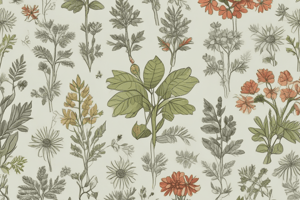Podcast
Questions and Answers
What is the main goal of Seasonal Color Analysis?
What is the main goal of Seasonal Color Analysis?
- To select colors that are currently trending in the fashion industry.
- To determine the most flattering color palette based on natural coloring. (correct)
- To teach individuals about the psychological effects of different colors.
- To analyze the historical significance of color in fashion.
Which color palette is associated with the Autumn season in Seasonal Color Analysis?
Which color palette is associated with the Autumn season in Seasonal Color Analysis?
- Bright, clear shades such as peach and coral.
- Bold, cool colors including royal blue and emerald green.
- Warm, earthy tones like olive green and burnt orange. (correct)
- Pastel colors and soft hues.
Which characteristic best fits individuals classified under the Summer season?
Which characteristic best fits individuals classified under the Summer season?
- Light hair colors with bright, clear eyes.
- Warm undertones and rich hair colors.
- Cool undertones with light to medium hair and muted eye colors. (correct)
- Bright, intense eye colors and dark hair.
What is the first step in the process of Seasonal Color Analysis?
What is the first step in the process of Seasonal Color Analysis?
In which season would you typically find individuals with dark brown or black hair and bright eye colors?
In which season would you typically find individuals with dark brown or black hair and bright eye colors?
Which option is NOT a characteristic of the Spring season?
Which option is NOT a characteristic of the Spring season?
What practical application does Seasonal Color Analysis NOT typically include?
What practical application does Seasonal Color Analysis NOT typically include?
Which color combination would be most flattering for someone categorized as a Spring type?
Which color combination would be most flattering for someone categorized as a Spring type?
Flashcards are hidden until you start studying
Study Notes
Seasonal Color Analysis
Overview
- Seasonal Color Analysis is a method used to determine an individual's most flattering color palette based on their natural coloring (skin tone, hair color, and eye color).
- It divides color palettes into four seasons: Spring, Summer, Autumn, and Winter.
The Four Seasons
-
Spring
- Characteristics: Warm undertones, light to medium hair (blonde, light brown), bright, clear eyes (blue, green).
- Color Palette: Warm, bright colors; pastels; clear and vibrant shades (e.g., peach, coral, warm pinks, yellow, light green).
-
Summer
- Characteristics: Cool undertones, often with light to medium hair (ash blonde, light brown), soft, muted eye colors (blue, gray).
- Color Palette: Soft, cool colors; pastels; muted shades (e.g., lavender, rose, soft blues, and grays).
-
Autumn
- Characteristics: Warm undertones, rich, deep hair colors (red, dark brown), warm, earthy eye colors (hazel, brown).
- Color Palette: Rich, warm colors; earthy tones (e.g., olive green, mustard yellow, rust, burnt orange).
-
Winter
- Characteristics: Cool undertones, dark hair (black, dark brown), bright, intense eye colors (dark blue, icy green).
- Color Palette: Bold, cool colors; jewel tones; stark contrasts (e.g., royal blue, emerald green, pure white, black).
Process of Analysis
- Step 1: Determine Undertones
- Assess skin undertone: warm (gold/yellow) or cool (pink/blue).
- Step 2: Analyze Natural Features
- Hair color and eye color play a critical role in determining the season.
- Step 3: Test Colors
- Use draping techniques with various colored fabrics to see which shades enhance the individual's appearance.
Importance of Color Analysis
- Enhances personal image and style.
- Aids in wardrobe selection, making shopping more efficient.
- Boosts confidence by choosing colors that complement natural features.
Practical Applications
- Personal styling and fashion advice.
- Makeup selection tailored to enhance one's features.
- Interior design color choices that resonate with personal style.
Seasonal Color Analysis Overview
- Method identifies flattering color palettes based on an individual's natural coloring: skin tone, hair color, and eye color.
- Color palettes divided into four categories: Spring, Summer, Autumn, Winter.
Spring Characteristics
- Warm undertones with light to medium hair (blonde or light brown).
- Bright, clear eyes often in shades of blue or green.
- Color palette features warm, bright colors and pastels, including peach, coral, warm pinks, yellow, and light green.
Summer Characteristics
- Cool undertones with light to medium hair (ash blonde or light brown).
- Soft, muted eye colors such as blue or gray.
- Palette consists of soft, cool colors and pastels, including lavender, rose, soft blues, and grays.
Autumn Characteristics
- Warm undertones with rich, deep hair colors (red or dark brown).
- Earthy eye colors like hazel or brown.
- Rich, warm colors dominate the palette, featuring earthy tones such as olive green, mustard yellow, rust, and burnt orange.
Winter Characteristics
- Cool undertones usually with dark hair (black or dark brown).
- Bright, intense eye colors, including dark blue or icy green.
- Palette includes bold, cool colors and jewel tones such as royal blue, emerald green, pure white, and black.
Process of Analysis
- Step 1: Determine Undertones
- Assess if skin undertone is warm (gold/yellow) or cool (pink/blue).
- Step 2: Analyze Natural Features
- Evaluate hair and eye color to assist in defining the season.
- Step 3: Test Colors
- Utilize draping techniques with colored fabrics to identify shades that enhance appearance.
Importance of Color Analysis
- Enhances personal image and style, allowing individuals to present themselves more effectively.
- Streamlines wardrobe selection, making shopping faster and more efficient.
- Increases confidence by enabling individuals to choose colors that complement their natural features.
Practical Applications
- Provides personal styling and fashion advice suited to individual characteristics.
- Guides makeup selection to enhance features in harmony with the individual's color palette.
- Informs interior design choices, ensuring colors resonate with personal style preferences.
Studying That Suits You
Use AI to generate personalized quizzes and flashcards to suit your learning preferences.




